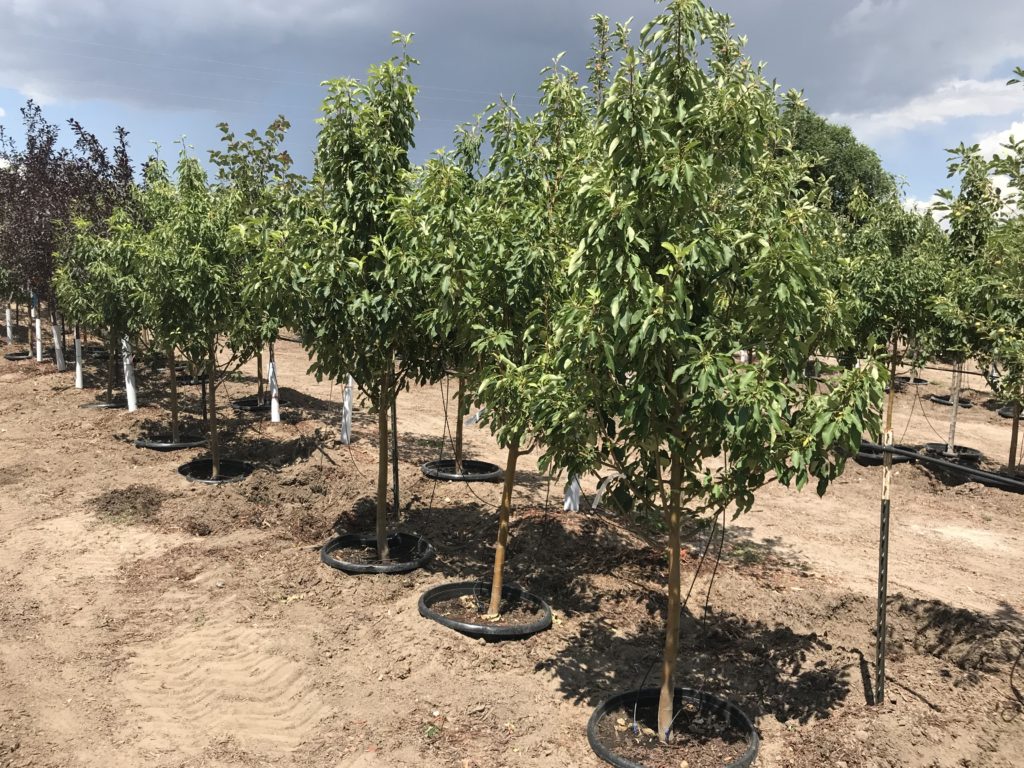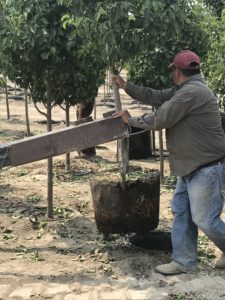Container trees are a convenient product with many benefits such as diversifying and helping address inventory challenges. As long as container trees are grown and delivered with proper care and watering, they can help retailers and wholesalers meet customer demand for high quality, year-round options.
“We do a lot of just-in-time inventory, and don’t have a lot of plants left at the end of the year,” said Levi Heidrich, a co-owner at Heidrich’s Colorado Tree Farm Nursery LLC in Colorado Springs. “We usually start shipping in container trees in June, after we’ve sold out of our spring crop. It’s easier for inventory management and cashflow. There’s lots of reasons to sell container trees.”
While ball and burlap trees can only be harvested in the fall, winter and spring when they are dormant, container trees can be shipped all summer long. Container trees also fill a customer need for smaller caliper trees. The smaller, lighter sizes as well as the convenient containers make them easy to handle, explained Heidrich.
“In Colorado Springs, a small lot with a five-foot setback between the house and fence might be filled with window wells, meters and air conditioning units, so there’s no room to get a dolly back there. Hand carrying container trees is an easy solution for those types of small sites,” he said.


Heidrich’s orders a good part of its container tree inventory from Clayton Tree Farm, which has two locations close to the Boise River in southwest Idaho. Joe Clayton, the grower’s business manager, agrees containers are designed to help customers who have limited space, even wholesalers and retailers who don’t have much room to store or display all the trees they can sell in a year. The ability to get new shipments of trees throughout the year provides more opportunities to sell and continue to bring in revenue beyond the spring rush.
“Being able to sell container trees throughout the year helps our customers in many different ways. It allows them to spread their expenses rather than having to bring all the material in during the spring rush. It also helps them limit the amount of material that they have on the ground in Colorado that is vulnerable to the Front Range’s often extreme summer hail storms,” Clayton said. “And freight has been surprisingly reasonable on a truckload of container trees. For example, last summer on a full truck of #25s (160 trees), we were generally able to land them into the Denver area for about $15 per tree.”
Clayton Tree Farm’s container crop consists of more than 50 deciduous varieties, ranging from ornamental and shade to fruit. They are grown in two ways, the smaller calipers — #7, #10 and #15 — are pot in pot while the #25 are grown in a pot in the ground that is specifically designed and fabricated for the grower. In both methods, a bareroot tree is placed in the pot to start, with a potting soil mix of top soil, bark, bark fines, and fertilizer.
“Top soil is an important component of our potting mix. It allows the tree to retain moisture while also promoting strong growth. That being said, finding the right ratio of ‘ingredients’ was important to us. We have tried to make sure we have a tree that will perform well while also being manageable to handle. Our #25s weigh between 150 and 200 pounds, so it’s feasible for two people to move them,” Clayton said.

“Not all varieties or sizes do as well in containers as they do in being field grown. If we can’t grow it in a container to look like our B&B, we have just chosen not to do it,” he said.
Heidrich’s purchases container sizes from #5 up to #30 from its suppliers for its customers. Most of the trees come in easy-to-handle, black plastic pots though some like aspens and evergreens come in root control bags.
“If evergreens are not rooted well in the bags, they need straw baskets to attach the root ball to the trunk for transport, or they can get loose,” Heidrich said. “We used to get air pots 15 years ago, but it was too humid where they came from, and they did not work here in our arid climate.”
If the soil media is too light, it can make it difficult for the tree to retain enough water, Heidrich emphasized. He orders from suppliers who use heavier potting soils, because the trees are more successful and he doesn’t see as many product returns as he did when selling containers with lighter soil media.
One disadvantage to container trees compared to B&B trees is the length of time that a retailer or wholesaler can store it. Heidrich’s doesn’t hold any containers beyond one growing season, but it can keep and sell B&B trees for a year if they are deciduous, and longer if coniferous.
Another possible downside to container trees is girdling and spiraling roots, which are a problem if they’re not grown correctly. Poor root balls can be caused by keeping trees in containers too long, and potting up overgrown #10s or #15s into larger containers.
“For us, as soon as a tree is rootbound and can’t be planted without shaving roots, it’s a loss,” he said. “We want to look at the root balls, so we sacrifice a tree by pulling it out of the container to see the quality of what is growing in the soil.”

Root structure, as well as head structure, is key to the long-term health of trees, whether in containers or B&B. Container trees with full root systems develop full heads with mature leaves. Pruning is just as necessary as with B&B trees to ensure they don’t become overgrown.
“Potted trees always look amazing in the nursery. They look big and dense and full, so people gravitate toward them. Next to a B&B tree, the consumer that doesn’t know about the potential root issues will go for the pot,” Heidrich observed.
“The market is so hot right now. As long as it lives and looks pretty, customers will want trees no matter how they were grown. But, I tell customers that they are not just buying leaves and stems, they are getting what is below the soil, too. We don’t want to sell someone a long-term problem. As long as customers water properly, and it’s our job to give them the right instructions, they are pretty successful with trees grown in containers.”










